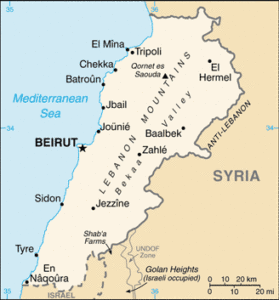Mohammed Sargi
Tyre
Tyre was located in what is modern Lebanon and is considered to have been originally a colony of Sidon. According to  Egyptian records they ruled it during the middle of the second millennium BC, but lost control when their influence in the area declined. Independence brought commercial success that saw Tyre surpass Sidon in wealth and influence and eventually establish its own colonies across the Mediterranean. One of these was Carthage in North Africa, which in time became independent and eventually rivalled the Roman Empire in the west. It also had colonies in Greece and frequently fought with Egypt.
Egyptian records they ruled it during the middle of the second millennium BC, but lost control when their influence in the area declined. Independence brought commercial success that saw Tyre surpass Sidon in wealth and influence and eventually establish its own colonies across the Mediterranean. One of these was Carthage in North Africa, which in time became independent and eventually rivalled the Roman Empire in the west. It also had colonies in Greece and frequently fought with Egypt.
The location of Tyre, on an island with a superb natural harbour and which had great wealth and was supported by its many colonies, has been seen as a mirror of Atlantis. The Old Testament prophecies of Ezekiel, writing around 600 BC, described (26:19, 27: 27-28) the destruction of Tyre in terms that have prompted some to link it with Plato’s description of Atlantis’ demise, written two hundred years later.*The earliest claim that Ezekiel’s Tyrus was a reference to Atlantis was made by Madame Blavatsky in The Secret Doctrine [1495] in 1888.
However, although both J.D. Brady and David Hershiser promote the idea of a linkage between Ezekiel’s Tyrus and Atlantis, they are certain that Tyrus is not the Phoenician city of Tyre. Beyond that, Brady identifies Tyrus/Atlantis with Troy, while Hershiser has placed his Tyrus/Atlantis in the Atlantic just beyond the Strait of Gibraltar(b).
Early in the 20th century Hanns Hörbiger also cited Ezekiel as justification for identifying Tyre as Atlantis.*
Recently, a sunken city has been discovered between Tyre and Sidon and according to its discoverer, Mohammed Sargi, is the 4,000 year old City of Yarmuta referred to in the Tell al-Amarna letters.
Carl Fredrich Baer, the imaginative 18th century writer, proposed a linkage between Tyre and Tyrrhenia. This idea has been  revived recently by the claims of Jaime Manuschevich[468] that the Tyrrhenians were Phoenicians from Tyre. Other supporters of a Tyrrhenian linkage with Tyre are J.D.Brady, Thérêse Ghembaza and most recently Dhani Irwanto. J.S. Gordon also claims[339.241] that Tyre was so named by the Tyrrhenians.
revived recently by the claims of Jaime Manuschevich[468] that the Tyrrhenians were Phoenicians from Tyre. Other supporters of a Tyrrhenian linkage with Tyre are J.D.Brady, Thérêse Ghembaza and most recently Dhani Irwanto. J.S. Gordon also claims[339.241] that Tyre was so named by the Tyrrhenians.
In Greek mythology it is said that Cadmus, son of the Phoenician king Agenor, brought the alphabet to Greece, suggesting a closer connection than generally thought.
J.P. Rambling places the Pillars of Heracles on Insula Herculis, now a sunken island, immediately south of Tyre(a).
(a) https://redefiningatlantis.blogspot.ie/search/label/Heracles
*(b) See: Archive 3395*
